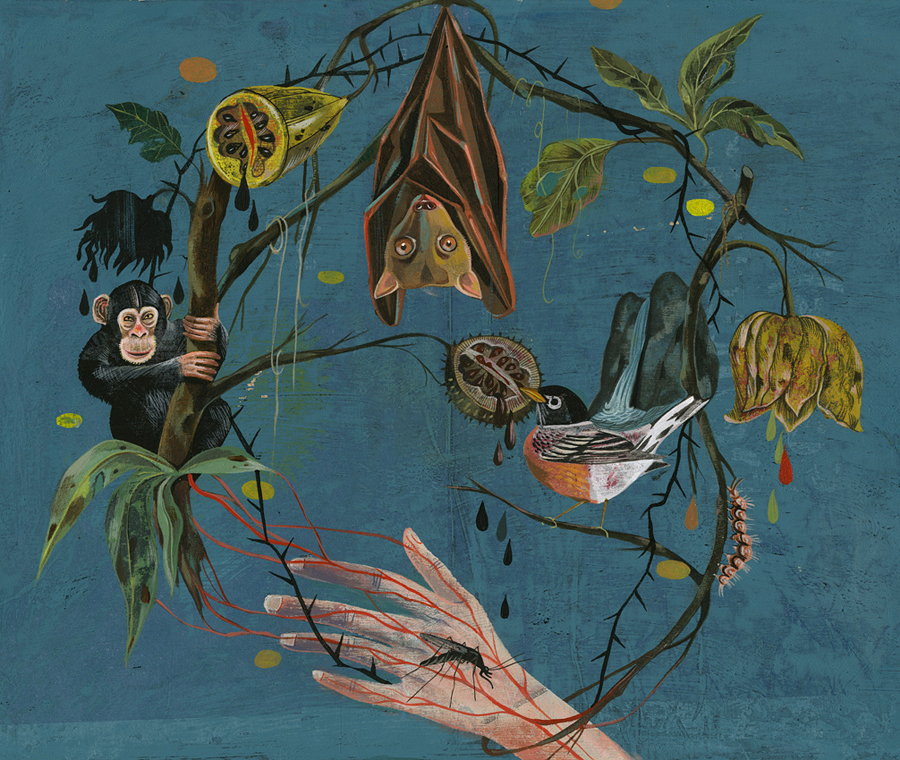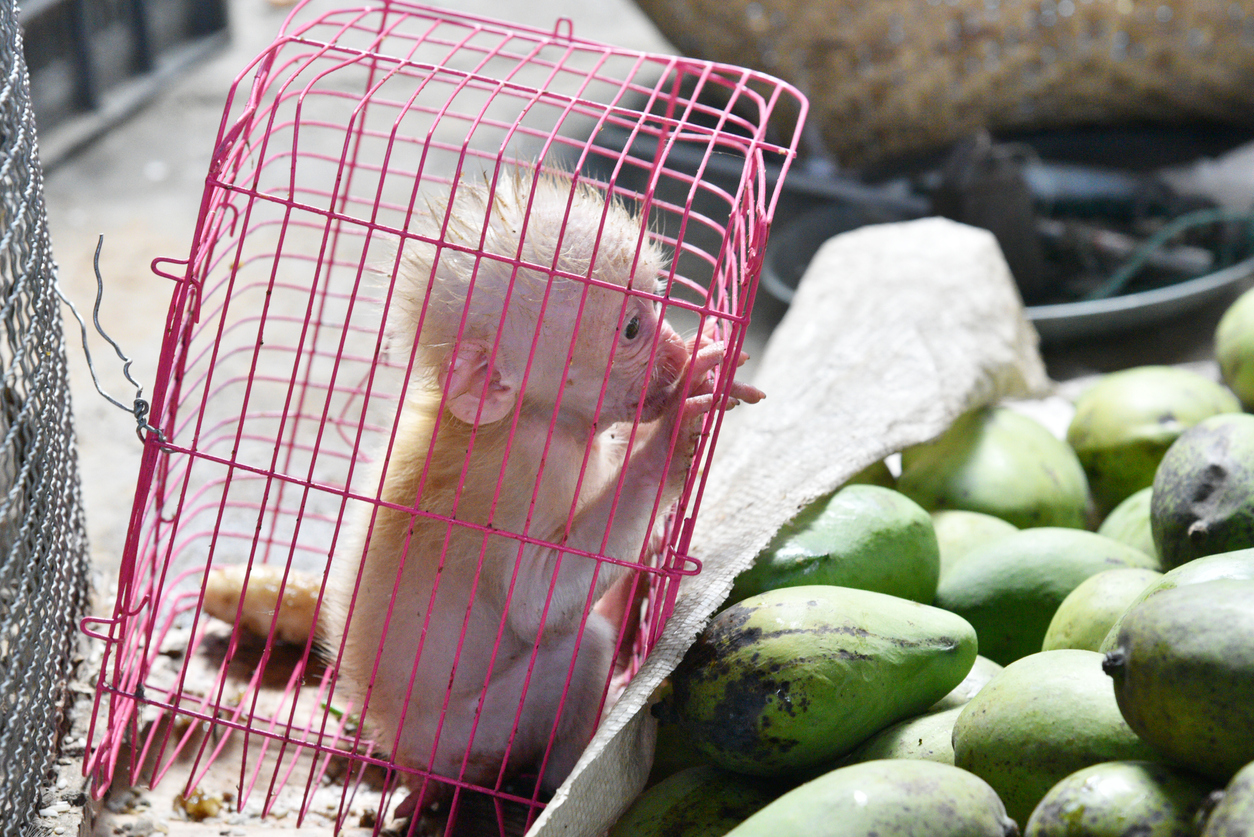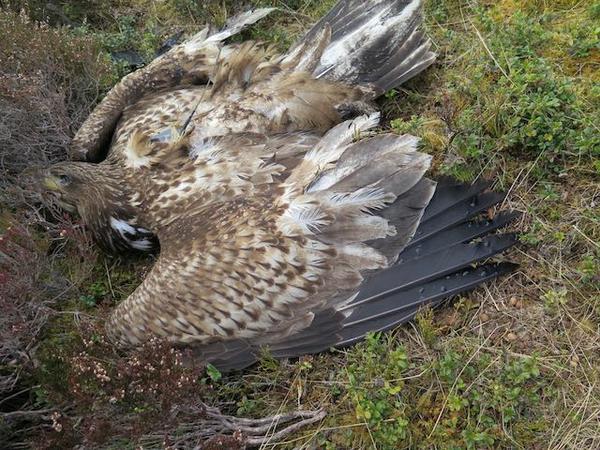“Scotland to ban mass culling of mountain hares” (The Guardian 18 June 2020) – Image courtesy of Robert Harding
Well, 2020 has been a year to remember and forget at the same time…..and as we head into 2021, the legacy of 2020 will be coming with us for the foreseeable……hopefully, in 2021 we can start to return to some kind of ‘normality’ but with the clear acknowledgement that the COVID-19 pandemic’s origins are of mankind’s own making.
Zoonotic Diseases of Mass Destruction
In early 2020, the COVID-19 pandemic made its world presence known, leaving a deadly, indelible mark on humanity.
Image courtesy of artist Olaf Hajek and The New York Times Sunday Review
COVID-19 was not unpredictable or some kind of ‘once in a 1,000 year event’ – the pandemic’s contributory factors were well known/understood. The next zoonotic disease/pandemic is already out there waiting to happen unless there is a global rethink of our interaction with (and destruction of) nature and treatment of wildlife/animals as mere ‘sustainable use’ commodity:
“The first thing to understand is that whatever future threats we’re going to face already exist; they are currently circulating in wildlife. Think of it as viral dark matter. A large pool of viruses are circulating and we don’t become familiar with them until we see a spillover event and people getting ill” – Dennis Carroll (PREDICT/Global Virome Project), “The Man Who Saw the Pandemic Coming,” Nautilus, 12 March 2020
The root cause of COVID-19 (SARS-CoV-2) is still to be fully verified. The science (“NIH moves to ax bat coronavirus grant draws fire,“ Science, 8 May 2020) at this stage, does not support the theory that SARS-CoV-2 was accidently/intentionally released from the Wuhan Institute of Virology (WIV) (or any other such laboratory). Shi Zhengli, leading WIV virologist and her team published the genome of a bat virus collected that shares 96.2% of its genome with SARS-CoV-2 – it is likely that this bat virus jumped to another mammal before mutating and infecting humans. The consensus is that the actual SARS-CoV-2 virus now circulating in humans is not ‘manmade or genetically modified,’ but mutated from the known bat virus genome published by Shi et al.
Therefore, we are currently left with the likelihood that the SARS-CoV-2 virus originated via an intermediary host, where this ability could have been acquired from a virus found in pangolins (Li et al. 2020) to infect a human – where the likely virus source infecting humans would have been via wildlife consumption (Andersen et al. 2020).
Therefore, there is little doubt that SARS-CoV-2 is related to known bat viruses and the health risks are ongoing, as more bat coronaviruses are documented from continued research.
The world’s focus is on the current pandemic and vaccinations for the SARS-CoV-2 virus and strains/variants that continue to emerge – however, the risk does not go away of future zoonotic disease pandemics unless all wildlife destruction, trading and consumption is risk-reviewed, properly managed and/or curtailed.
[Update] “How we continued destroying the natural world in 2020,” Jane Dalton, The Independent, 26 December 2020
The Wildlife Trade and Live Wildlife Markets
Baby monkey in a cage. The black market business of wildlife trafficking – Licensed i-Stock image
The ‘legal’ and illicit wildlife trade continues to present global human health risks – the trade in wildlife covers a vast spectrum and is a multi-billion dollar per annum global industry. A report (Baker et al. 2013) found that the illegal wildlife trade accounted for 59% of the trade reported/uncovered (with the illegal trade estimated by Interpol to be worth $20bn per annum), with legal trade accounting for 41% (though ‘legal’ trade can also be orchestrated for illicit means of course).
Mitigating the risks within all forms of wildlife trade are unlikely to be emerge from ‘smart regulation’ (a form of self-regulation some ‘sustainable utilisation’ advocates give as a potential panacea) to ensure legal and regulatory compliance.
For example, the chemical industry’s failed ‘self-regulation’ has left an enduring legacy of toxic pollution, embedding harmful ‘forever’ chemical in the air, water and soil around the world – chemicals such as PFAS and PFOS, or per-and-polyfluoroalkyl a poorly ‘regulated’ chemical created (pioneered by 3M) and used by the DuPont Chemical Company in the manufacture C8/Teflon.
The resulting toxic legacy of PFAS/PFOS was the subject of the 2019 film, ‘Dark Waters‘ (based on the book, ‘Exposure,’ by Robert Bilott). The toxic pollution (that we all now wallow in) has been linked to severe illnesses:
“…including kidney cancer, testicular cancer, ulcerative colitis, thyroid disease, and pregnancy-induced hypertension. And more recent studies are now raising concerns that some of these forever chemicals may negatively impact our endocrine system, our fertility, and our immune system – and possibly even the efficacy of vaccines. Frightening news, indeed, when we are all trying to fight off a worldwide pandemic and need our vaccines to be as effective as possible” – “The poison found in everyone, even unborn babies – and who is responsible for it,” Robert Bilott, (author and Partner, Taft Stettinius & Hollister, LLP), The Guardian, 17 December 2020
So, these ‘forever’ chemicals continue to accumulate in every human (even babies in their mother’s womb), potentially harming every living creature for evermore on our planet, not just by accident, but knowingly compounded by a ‘self -regulating’ chemical industry and their advocates’ corruption, deceit and greed. These same traits and drivers are clearly evident within the wildlife trade.
Not wishing to labour the point, but the chemical industry knowingly continuing to poison every human/living creature on the planet is not a good advert for having any faith in self-regulation/’smart regulation’ as a solution to anything, let alone the wildlife trade’s issues/risks. Note: PFAS/PFOS chemicals have yet to be banned and/or their non-essential use phased out – is it time for a ‘Paris agreement’ for toxics? The answer must be surely be ‘yes.’
Unless there is a paradigm shift in the way wildlife trading is conducted, then the risks posed by the trade to human health will continue to multiply – at the moment, there remains a vacuum in which viruses such as COVID-19 can manifest and thrive, which should concern us all (even those that prosper from and defend wildlife trading in all its cruel and exploitative forms).
United Kingdom Import and Export of Hunting Trophies
At the end of 2019, the United Kingdom (UK), Government Consultation was launched by the Department of Environment, Food and Rural Affairs (DEFRA):
- “Consultation on controls on the import and export of hunting trophies” (closed 25 February 2020); and
- “Call for Evidence on the scale and impacts of the import and export of hunting trophies” (closed 25 February 2020).
IWB submitted a response to both parts of the consultation, December 2019. As of December 2020, the conclusions of this UK government consultation are still awaited.
United Kingdom Ivory Trade
Following on from the 2017 public consultation on ivory trading in the UK (IWB’s submission, November 2017) and the government’s subsequent legislation to prohibit the vast majority of such trade, IWB has been supporting the 2019/20 campaign to ensure that the Ivory Bill (2018) legislation is enacted, in full and unhindered. A privately funded appeal (by the antiques trade and collectors (FACT)) against the High Court’s 2019 decision (to reject the ivory ban challenge) was heard 24th/25th February 2020, at the High Court, The Strand, London.
The Ivory Bill was duly upheld by the High Court, May 2020. The last resort for appeal was the Supreme Court – but that path of appeal was refused in August 2020. The Ivory Act (2018) legislation (as enacted) is now due to become law (DEFRA is consulting on the implementation details) [the delay in implementation is costing elephant lives]. The extension/consultation to encompass other persecuted species such as “.…hippos, walruses and narwhals” is awaited as the absence of all ivory bearing species within the Act clearly provides loop-holes for exploitation.
Critical Protections for Captive Big Cats One Step Closer to Becoming Law
In the United States, December 2020, the Big Cat Public Safety Act (H.R. 1380) in the U.S. House of Representatives in a 272 – 114 vote, bringing the bill a significant step closer to becoming law:
“Big cats are wild animals that simply do not belong in private homes, backyards, or shoddy roadside zoos. Too often, law enforcement and first responders are the ones who end up in danger from these animals” – Born Free USA, 3 December 2020
In addition, the long-overdue introduction of a U.S. Federal Bill to curb commercial trade and cruel traps is also welcomed.
South Africa
The High Level Panel (HLP) was formed (in theory) to “review existing policies, legislation and practices relating to the management and handling, breeding, hunting and trade of elephant, lion, leopard and rhinoceros.”
However, the HLP’s terms of reference and constitution make its true objectives questionable.
In the meantime, South Africa’s disparate wildlife exploitation (‘sustainable utilisation’) policies continue to expand.
We shall see if/when the HLP reports if there is any recognisable shift away from South Africa’s exploitative practices….but vested interests (for example, President Ramaphosa) may have already pre-determined the outcome.
Trophy Hunting
In 2020, a number of books/documentaries exposed the veil of lies which trophy hunting hides behind –
“Trophy Hunters Exposed,” “Unfair Game,” “Killing Game – The Extinction Industry,” “Trophy Leaks: Trophy Hunters and Industry Secrets Revealed“…..
Plus, the revelation of the pro-hunting lobbies’ twisted corruption of social media platforms to try and gain a more positive image – which in reality has only succeeded in confirming the hunting lobbies’ inherent self-delusion and its continued, failed attempts to deceive those that do not share those delusions.
The pro-trophy hunting lobbies’ delusions are still ably supported by a small, loyal band of ‘scientists’ – but the credibility of their increasingly desperate arguments only seems to expose the weakness and bias in their enduring support for trophy hunting.
In Scotland, there is a welcomed shift towards increased regulation of hunting, with the announced intention to licence grouse shooting with the incentive being to reduce grouse shooting’s negative impacts and on-going persecution of species that prey on grouse and the commercial interests of the industry.
Image courtesy of Police Scotland who said “As well as being illegal, poisoning is a cruel way to kill a bird. It also puts the lives of other creatures and plants at risk and impacts negatively on our environment”
Let’s hope for a kinder, safer 2021.




